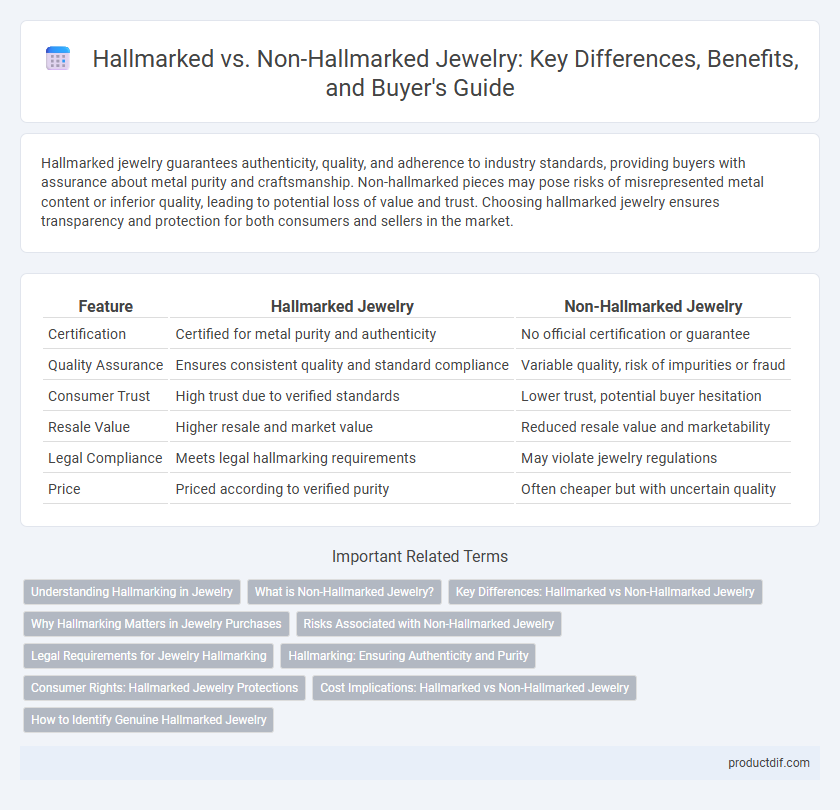Hallmarked jewelry guarantees authenticity, quality, and adherence to industry standards, providing buyers with assurance about metal purity and craftsmanship. Non-hallmarked pieces may pose risks of misrepresented metal content or inferior quality, leading to potential loss of value and trust. Choosing hallmarked jewelry ensures transparency and protection for both consumers and sellers in the market.
Table of Comparison
| Feature | Hallmarked Jewelry | Non-Hallmarked Jewelry |
|---|---|---|
| Certification | Certified for metal purity and authenticity | No official certification or guarantee |
| Quality Assurance | Ensures consistent quality and standard compliance | Variable quality, risk of impurities or fraud |
| Consumer Trust | High trust due to verified standards | Lower trust, potential buyer hesitation |
| Resale Value | Higher resale and market value | Reduced resale value and marketability |
| Legal Compliance | Meets legal hallmarking requirements | May violate jewelry regulations |
| Price | Priced according to verified purity | Often cheaper but with uncertain quality |
Understanding Hallmarking in Jewelry
Hallmarking in jewelry guarantees metal purity by certifying precious metals such as gold, silver, and platinum through official stamps from authorized assay offices. Non-hallmarked jewelry lacks this certification, posing potential risks regarding metal authenticity and value. Understanding hallmarking helps consumers make informed decisions, ensuring quality, trustworthiness, and compliance with international standards.
What is Non-Hallmarked Jewelry?
Non-hallmarked jewelry refers to pieces that lack an official certification stamp verifying the metal's purity and authenticity, often resulting in uncertainty about the material quality. These items may be made from precious metals like gold or silver but have not undergone testing or approval by authorized hallmarking bodies. Consumers risk purchasing non-hallmarked jewelry without assurance of genuine metal content, making hallmarking a critical factor in ensuring trust and value.
Key Differences: Hallmarked vs Non-Hallmarked Jewelry
Hallmarked jewelry carries a certified stamp from authorized assay offices guaranteeing metal purity and authenticity, while non-hallmarked pieces lack such official validation, increasing uncertainty about their quality. The hallmark ensures compliance with legal standards, offering consumers protection and confidence in their purchase. In contrast, non-hallmarked jewelry may vary significantly in metal content, potentially leading to inferior durability and value.
Why Hallmarking Matters in Jewelry Purchases
Hallmarking in jewelry certifies the metal's purity, ensuring buyers receive genuine and high-quality pieces that meet legal standards. Non-hallmarked jewelry poses risks of metal fraud, lower durability, and potential financial loss due to inaccurate metal content. Choosing hallmark-certified jewelry guarantees authenticity, enhances trust, and protects consumer rights in the market.
Risks Associated with Non-Hallmarked Jewelry
Non-hallmarked jewelry poses significant risks such as uncertain metal purity, leading to potential financial loss and allergic reactions due to undisclosed alloys. Consumers face challenges in verifying authenticity, increasing vulnerability to fraud and counterfeit items. The lack of standardized quality assurance in non-hallmarked pieces compromises durability and resale value.
Legal Requirements for Jewelry Hallmarking
Legal requirements for jewelry hallmarking vary by country, ensuring consumer protection through verified metal purity standards. Hallmarked jewelry undergoes strict testing and certification processes mandated by government authorities, which non-hallmarked pieces lack, increasing risks of fraud and misrepresentation. Compliance with hallmarking laws guarantees authenticity, traceability, and quality assurance in precious metal products.
Hallmarking: Ensuring Authenticity and Purity
Hallmarking guarantees the authenticity and purity of jewelry by providing certified stamps that verify metal content and quality. This process protects consumers from counterfeit products and ensures compliance with international standards. Jewelry with hallmark certification offers transparency and trust, enhancing its value and resale potential.
Consumer Rights: Hallmarked Jewelry Protections
Hallmarked jewelry guarantees authenticity, metal purity, and quality standards, ensuring consumer protection against fraud and counterfeit products. Non-hallmarked pieces lack verified certification, increasing the risk of purchasing substandard or misrepresented items. Consumer rights are strongly supported by hallmarking regulations, offering legal recourse in cases of disputes or defective jewelry.
Cost Implications: Hallmarked vs Non-Hallmarked Jewelry
Hallmarked jewelry typically commands a higher price due to certification costs and guaranteed metal purity, ensuring long-term value and buyer confidence. Non-hallmarked jewelry may appear cheaper upfront but risks potential loss in resale value and quality assurance. Investing in hallmarked pieces minimizes financial risks associated with counterfeit or substandard metals.
How to Identify Genuine Hallmarked Jewelry
Genuine hallmarked jewelry can be identified by examining the stamp that includes specific symbols such as the maker's mark, metal purity, and assay office mark, which confirm authenticity and quality standards. Hallmarked pieces are typically accompanied by certificates or documentation verifying the metal content and origin. Non-hallmarked jewelry lacks these standardized marks, increasing the risk of low-quality metals or counterfeit materials.
Hallmarking vs non-hallmarking Infographic

 productdif.com
productdif.com